Steve Redick submitted a video with radio traffic from Sunday morning’s 5-11 and Level I at 2620 W. Nelson. Steve was at the scene for 5 hours.
19 engines were pumping at the scene (106, 91, 76, 78, 112, 124, 43, 110, 56, 55, 57, 59, 14, 30, 22, 26, 44, 94, 69) along with master streams from three tower ladders (10, 21, 23), two Snorkels (S2A, 6-1-1) and seven multi-versals.
Larry Shapiro submitted several images from the fire having spent 8 hours at the scene.
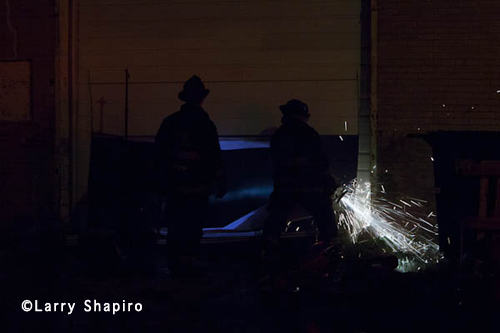
Firefighters from Squad 2 cut into an overhead door for access to the exposure building. Larry Shapiro photo
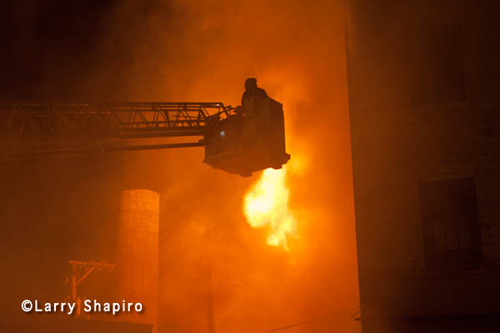
Fire blows out of a window on the west side of the building as Tower Ladder 10 maneuvers into position to hit the flames. Larry Shapiro photo
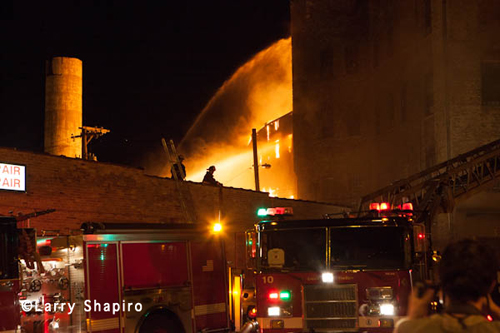
After a vertical collapse of three floors, heavy fire silhouettes the remaining wall as master streams are directed at the flames from the alley and a neighboring building. Larry Shapiro photo

Thick smoke pushes out of the upper floors of the building on the south side as Tower Ladder 10 works it’s way across the face. Larry Shapiro photo
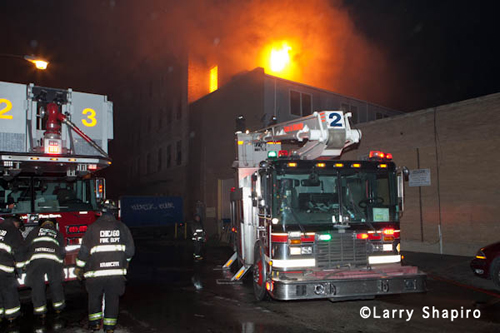
Tower Ladder 23 and Squad 2A prepare to put elevated master streams into operation. Larry Shapiro photo
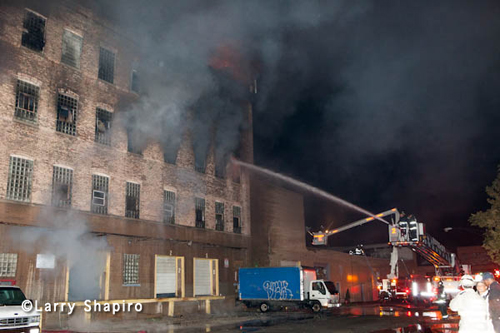
Squad 2A and Tower Ladder 23 work along the east side of the four-story building. Larry Shapiro photo
Several of Chicago’s specialty units were deployed at this fire scene including 6-6-1 (the 1982 85′ reserve Snorkel), turret wagon 6-7-6 out of Engine 104’s house, 9-2-4 (the MVU), hose wagon 6-1-2, 5-1-2 from O’Hare, 5-7-2 from Engine 68’s house, and 2-7-2. (9-1-3 was at the scene but not utilized)
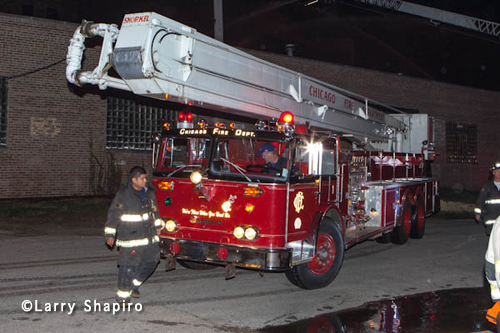
Reserve Snorkel 1 out of Engine 35’s house was brought to the scene. Larry Shapiro photo
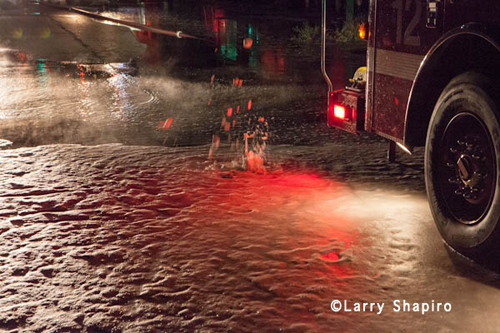
A Level I haz mat was requested so that this soap-like solution bubbling out of the sewer could be analyzed. Larry Shapiro photo

5-1-2 responded in the spare haz mat unit as painted and lettered for the tv show being filmed in Chicago. Larry Shapiro photo
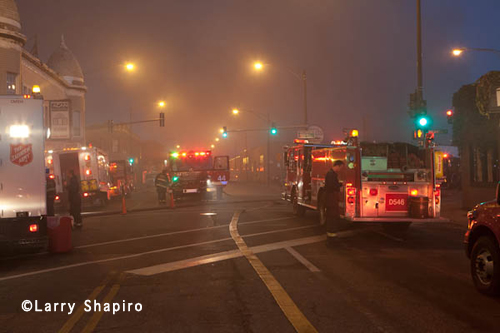
The large number of master streams being deployed required in-line pumping operations down Elston Avenue to the southeast, and another originating on Belmont and traveling down Rockwell to Engine 78. Larry Shapiro photo
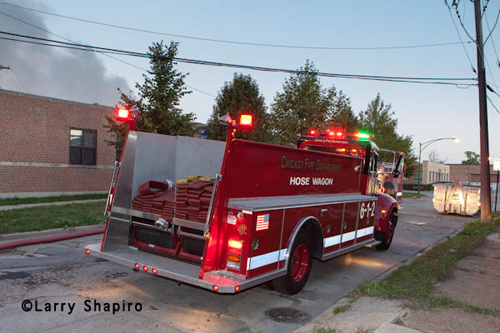
Hose Wagon 6-1-2 came with Engine 26 who anchored an in-line operation with four other engines. Larry Shapiro photo
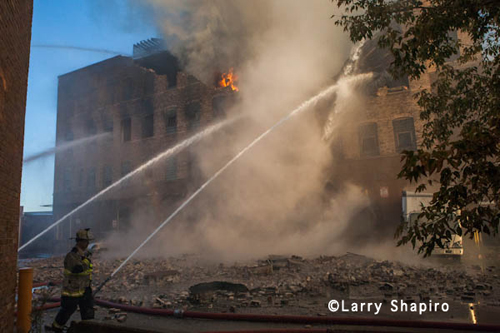
Two tower ladders and three multi-versals continued to work along Nelson after a large section of the wall collapsed. Larry Shapiro photo
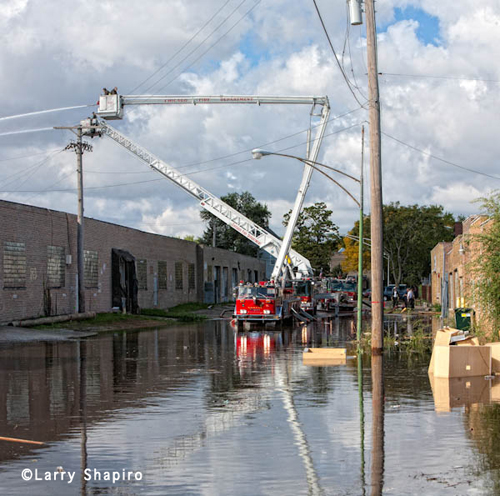
Barry Avenue in the rear of the fire scene looked like a small lake as the water runoff overwhelmed the sewer system seven hours into the fire. Larry Shapiro photo
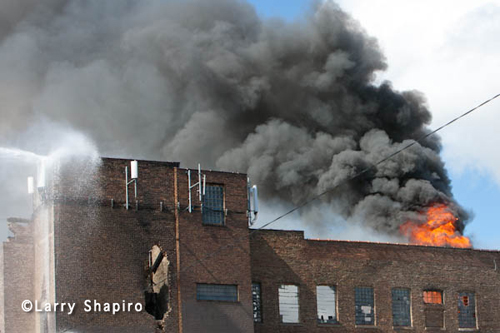
Eight hours into the operation, the fire burned through a section of the roof that was still intact after master streams were shut down to allow the fire to vent itself. Larry Shapiro photo
Four large-diameter lines fed Turret Wagon 6-7-6 so that both guns could be deployed to try knocking down some of the exterior walls for better access to the remaining fire.
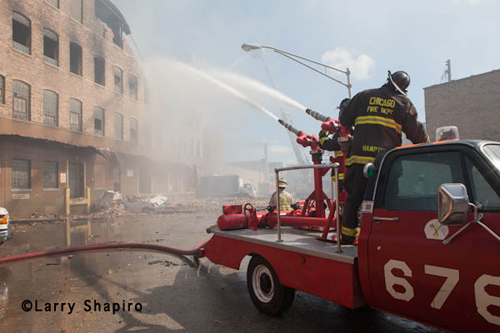
Turret Wagon 6-7-6 came all the way from Engine 104’s quarters since 6-7-3 (the north side turret wagon) was out of service. Somewhat of a rare image here as the unit sees very little service. Larry Shapiro photo
A large gallery of images can be found HERE.
We look forward to images from Tim Olk who was at the fire scene for 12 hours including the initial building demolition by a wrecking company.
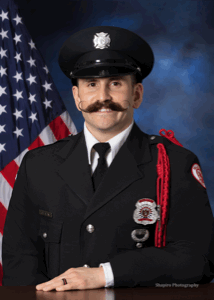
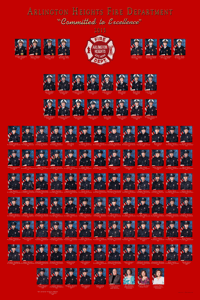
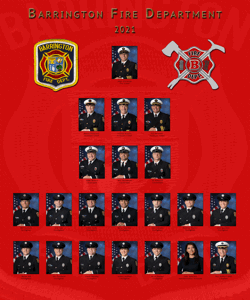
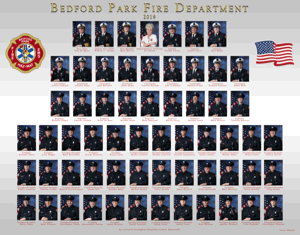
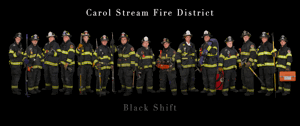
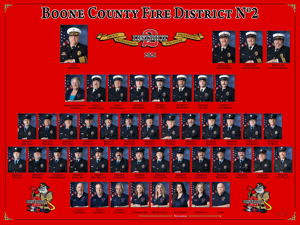
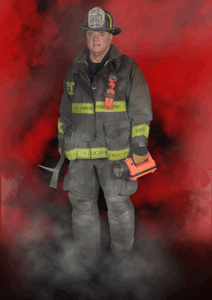
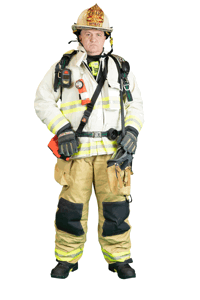
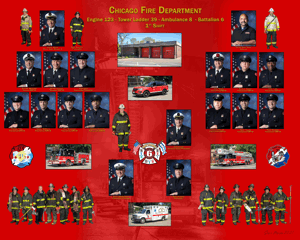
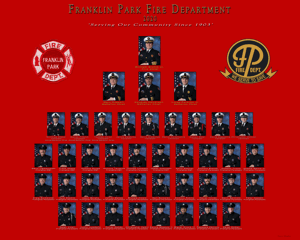
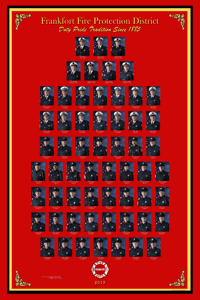
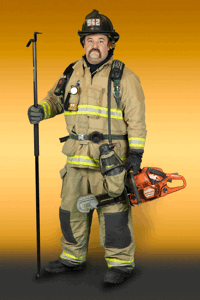
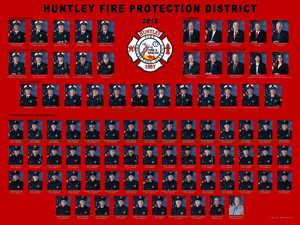
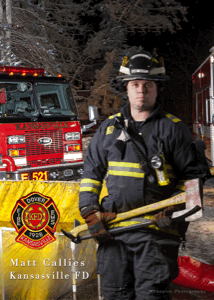
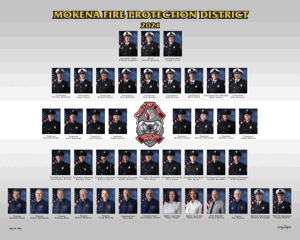
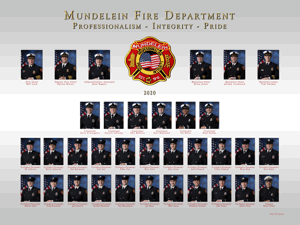
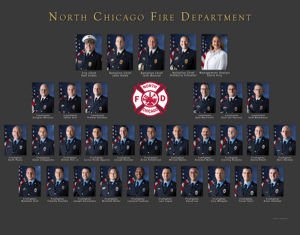
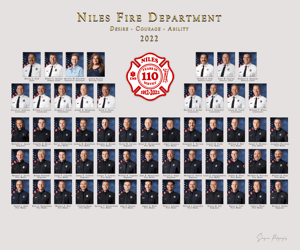
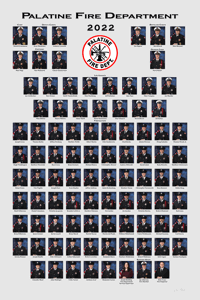
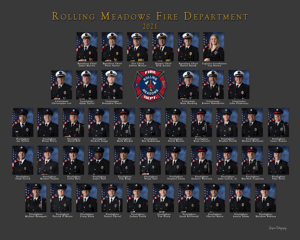
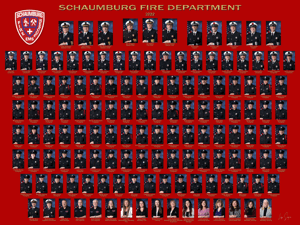
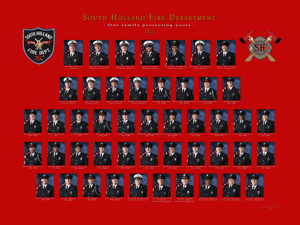
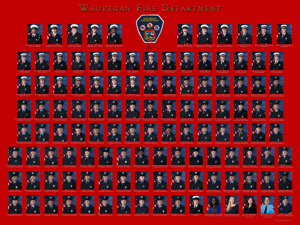
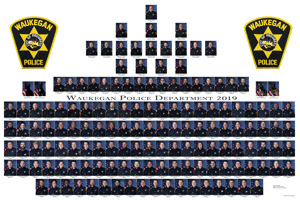
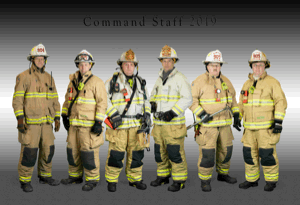
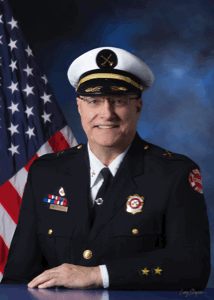
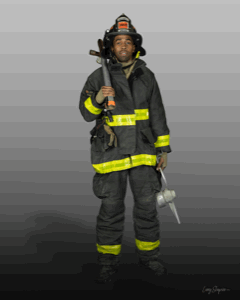
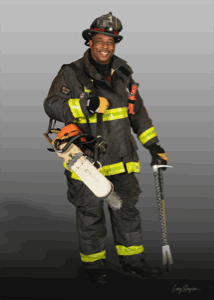
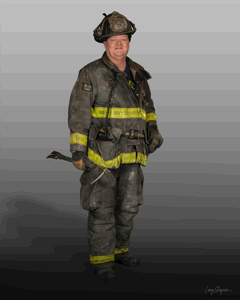






















#1 by Bill Post on October 2, 2012 - 10:42 PM
Scott “Big Mo” and it’s larger counterpart “Big John” were both taken out of service in the late 1970s from Engine 42’s quarters where they were both located. Big Mo was taken out of service in 1977 and Big John was taken out of service in 1978. 671, the large deluge wagon had originally gone in service as 675 on December 27, 1976, also at Engine 42’s quarters. In those days all of the large deluge wagons were running out of Engine 42’s quarters and they had dedicated manning (a driver) and responded on 2-11 alarm fires city wide. 675, which was also known at the “Super Deluge Wagon” at one time, was renumbered to reflect the fire district that it was assigned to on January 20, 1983 when the fire department started renumbering the light wagons and deluge units based on the fire district that they were assigned to.
An irony is that 675 was relocated in July of 1981 to Engine 104’s old quarters which was at 1401 S. Michigan. In early 1982, it was relocated to Engine 47’s current quarters. They had exchanged the Mack MB deluge wagon for a smaller wagon (such as the ones that 676 and 673 currently use) and the Mack MB was relocated to Engine 1’s house where it had become 671. Since that time, in July of 1982 the (recently retired) Mack MB deluge wagon had been known as 671. They were eventually relocated to Engine 23’s house where they were recently taken out of service.
#2 by Mike McAuliffe on October 2, 2012 - 1:24 PM
If you guys have good video of 5-1-2’s spare rig at the fire you should try selling it to the television production company for “Chicago Fire”. Seriously!
#3 by David on October 2, 2012 - 5:07 AM
Nice pics, it has been ages since the last 5-11. Great to see 5-1-2 with the spare rig, that’s some unique sight. As to 6-7-1, it was taken out of service a few months ago and from what I’ve heard they probably won’t replace the rig. Looks like the small turret rigs are sufficient to cover the whole city now.
#4 by Scott on October 2, 2012 - 12:59 AM
Is that the MABAS logo on “Sqd 3″/5-1-2 put on for the Tv show?
Also anyone know what will become of 6-7-1 as mentioned taken out of service. Was that “Big Mo”?
#5 by chris r on October 1, 2012 - 11:02 PM
GOOD JOB AGAIN by chicagoareafire.com on CHICAGO’S 5-11. Chicagoareafire has always been there when there is a major fire in chicago and the suburbs from the southside of the city and all the way to the WISCONSIN border and beyond. You can find out what’s going on fire department wise in the chicagoland area. (even if they don’t print my newspaper referrals anymore) SO GOOD JOB AGAIN GUYS. CHRIS R
\\\
#6 by DMc77 on October 1, 2012 - 8:54 PM
There are still a good number of large warehouse type buildings like this one that have remained in Chicago. The difference in the buildings still standing is that they are sprinklered. The initial call to this building apparently was for an automatic fire alarm, but due to it’s size and the delay in companies’ ability to get to the seat of the fire quickly enough, it turned out to be a total loss. I’m sure the other sprinklered warehouse buildings in the city have had fires in them before, but the fires were held in check by the fire protection systems allowing the responding companies the time they need to reach the location of the fire before it grew too big making an interior fire attack impractical.
#7 by george eimer on October 1, 2012 - 7:44 PM
671 taken out of service weeks ago for good. 673 was out of service at time of 5-11
#8 by Bill Post on October 1, 2012 - 7:12 PM
You don’t get many fires like this anymore. I wonder what the cause was?
I notice that 676 was sent from the far south side. Isn’t 673 at Engine 108 any more or what about 671 (the large deluge wagon) at Engine 23?
#9 by MP on October 1, 2012 - 7:10 PM
Thank you to all who took pictures at the 511. It’s great to see all the different rigs that were working. I appreciate your efforts!